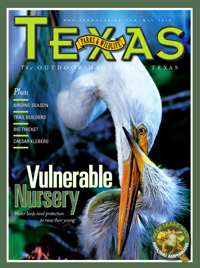
Park Pick: Where Dinosaurs Roamed
Low river levels allow hundreds of footprints to be documented at Dinosaur Valley State Park.
By Sheryl Smith-Rodgers
Even in times of extreme drought, people like Mike O’Brien and Glen Kuban can find a bright spot. Last summer, the pair — aided by more than a dozen volunteers — spent countless hours at Dinosaur Valley State Park, documenting 470 dinosaur footprints laid bare by a dry Paluxy River.
“We knew the tracks were there, but we didn’t know to that extent,” says O’Brien, a graphics designer with the Texas Parks and Wildlife Department. “Because the river was so low, we were able to clean them out and map them for the first time.” By year’s end, O’Brien will complete a comprehensive map of the park’s 2,000-plus known indentations, left largely by three-clawed, meat-eating theropods and round-toed, vegetarian sauropods.
Kuban, a paleo enthusiast who’s frequented the park since 1980, traveled from his Ohio home to join the weeklong project last July. “We used water hoses, leaf blowers, push brooms, shovels, whisk brushes, sponges and toothbrushes to clean an area that was bigger than a football field,” he says. “The tracks there are so good that it looks like dinosaurs just walked by five minutes ago.” Experts were also excited to discover baby sauropod footprints among the tracks.
This summer, the Paluxy may be back up, but visitors can still check out trackways at four sites within the park. Every Saturday, interpreter Kathy Lenz leads groups across the river to get an up-close look at theropod and sauropod prints. “I tell how they were made 113 million years ago and what Texas was like back then,” she says. “Then I answer questions. Depending how interested people are, we sometimes stay as long as four hours.”
Two gigantic dinosaurs — constructed from fiberglass for the 1964-65 World’s Fair — stand not far from the park store, where visitors can buy dinosaur stuff (books, caps, toys and more) plus drinks and snacks.
Extended stays allow more time to explore the 1,596-acre park, which offers 12 miles of hike-and-bike trails, day-use horseback riding areas and camping facilities. Visitors can also swim and fish in the river.
FYI: Scratch Pleurocoelus as Texas’ official state dinosaur. Meet Paluxysaurus jonesi, the sauropod that once tromped through Dinosaur Valley State Park. The name change stems from a master’s-level study published by Peter Rose in 2007.
“Track Talk in the River” tours start at 2 p.m. Saturdays at Track Site No. 2, weather permitting. Wear old shoes or water shoes or go barefoot. Dinosaur Valley State Park is four miles west of Glen Rose. For more information, call 254-897-4588 or visit www.tpwd.state.tx.us/dinosaurvalley.

